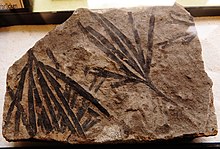| Baiera Temporal range: 298.9–94.3 Ma PreꞒ Ꞓ O S D C P T J K Pg N Permian–Cretaceous | |
|---|---|

| |
| Baiera gracilis fossil | |
| Scientific classification | |
| Kingdom: | Plantae |
| Clade: | Tracheophytes |
| Clade: | Gymnospermae |
| Division: | Ginkgophyta |
| Class: | Ginkgoopsida |
| Order: | Ginkgoales |
| Family: | Ginkgoaceae |
| Genus: | †Baiera Braun [de], 1843 |
| Species | |
|
†Baiera africana | |
Baiera is a genus of prehistoric gymnosperms in the order Ginkgoales. It is one of the oldest fossil foliage types of Ginkgoales, and is related to the genera Ginkgo and Ginkgoites. Fossils of Baiera are found worldwide, and have been known from the Permian to the Cretaceous.
Description

Baiera species are characterized by fan-shaped leaves, are deeply lobed into four segments, deeply incised into slender segments, and are distinguished from Sphenobaiera by a petiole.
B. africana is characterized by its symmetrical and triangular leaves.
Classification
Karl Friedrich Wilhelm Braun first introduced the name Baiera in 1843 to refer to fossils in Germany that he interpreted as ginkgophytes. In 1936, Carl Rudolf Florin used Baiera to refer to leaves with a distinct stalk or petiole and with a semicircular or triangular shape.
Placement of Baiera
Gerd Dietl and Günter Schweigert (2011) place Baiera in the family Ginkgoaceae, while a 2015 classification by Andriy Novikoff and Beata Barabasz-Krasny places it in the Karkeniaceae.
References
- "Fossilworks: Baiera". fossilworks.org.
- ^ "Fossilworks: Baiera". fossilworks.org. Retrieved 17 December 2021.
- Guignard, Gaëtan; Yang, Xiao-Ju; Wang, Yong-Dong (2019-09-01). "Cuticle ultrastructure of Baiera furcata from Northeast China and its implication in taxonomy and paleoenvironment". Review of Palaeobotany and Palynology. 268: 95–108. Bibcode:2019RPaPa.268...95G. doi:10.1016/j.revpalbo.2019.05.006. ISSN 0034-6667. S2CID 199103806.
- ^ Pott, Christian & Burgh, J. & van Konijnenburg-van Cittert, Johanna. (2016). New Ginkgophytes from the Upper Triassic–Lower Cretaceous of Spitsbergen and Edgeøya (Svalbard, Arctic Norway): The History of Ginkgoales on Svalbard. International Journal of Plant Sciences. 177. 175-197. 10.1086/684194.
- "Ginkgophyte | plant division". Encyclopedia Britannica. Retrieved 2018-02-03.
- Barboni, Ronaldo; Dutra, Tânia Lindner (November 2015). "First record of Ginkgo-related fertile organs (Hamshawvia, Stachyopitys) and leaves (Baiera, Sphenobaiera) in the Triassic of Brazil, Santa Maria formation". Journal of South American Earth Sciences. 63: 417–435. Bibcode:2015JSAES..63..417B. doi:10.1016/j.jsames.2015.08.001.
- ^ Bauer, K.; Kustatscher, E.; Krings, M. (2013). "The ginkgophytes from the German Kupferschiefer (Permian), with considerations on the taxonomic history and use of Baiera and Sphenobaiera". Bulletin of Geosciences: 539–556. doi:10.3140/bull.geosci.1394 – via Core.
- "IRMNG - Baiera C.F.W. Braun, 1843 †". www.irmng.org. Retrieved 2021-05-09.
- Novikoff, Andrew; Barabasz-Krasny, Beata (2015). Modern plant systematics. Liga-Pres. doi:10.13140/RG.2.1.4745.6164.
| Taxon identifiers | |
|---|---|
| Baiera | |
This article about a prehistoric gymnosperm is a stub. You can help Misplaced Pages by expanding it. |